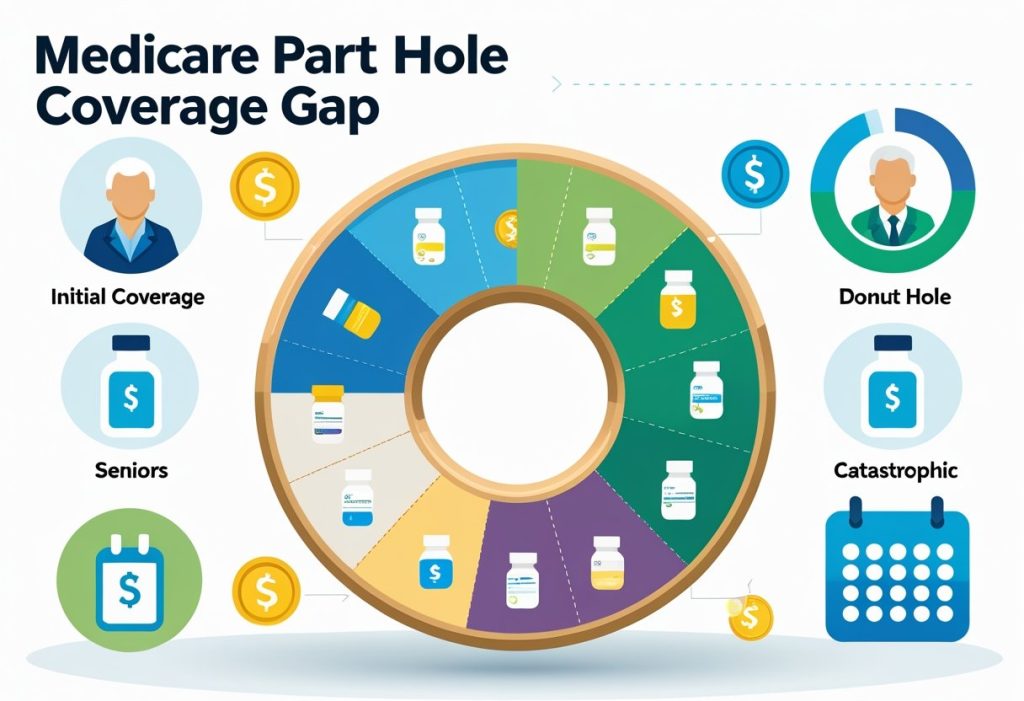Navigating Medicare can be complex, especially with aspects like the Part D donut hole. The donut hole, or coverage gap, refers to a temporary phase in Medicare Part D that can significantly affect your prescription drug costs. Understanding how this gap works is crucial for managing your healthcare expenses effectively.
As you explore your options, keep in mind that knowing the details about the donut hole can help you avoid unexpected costs. The Modern Medicare Agency stands ready to assist you in identifying the best Medicare packages tailored specifically to your needs. With our licensed agents, you will receive personalized support without worrying about hidden fees.
Taking control of your Medicare experience starts with understanding key components like the donut hole. With reliable guidance from The Modern Medicare Agency, you can make informed decisions that benefit your health and budget.
What Is the Medicare Part D Donut Hole?
The Medicare Part D donut hole refers to a specific phase in Medicare’s prescription drug coverage. Understanding its implications and historical context can help you navigate your options effectively.
Defining the Coverage Gap
The donut hole, or coverage gap, is a period within the Medicare Part D plan where beneficiaries face higher out-of-pocket costs for prescription drugs. After reaching a certain threshold in drug spending, you enter this phase, where you pay a larger share of your medication costs. Once your expenses exceed a specific limit, catastrophic coverage kicks in, significantly reducing your out-of-pocket expenses for the rest of the year.
This phase used to create financial strain for many beneficiaries, having a major impact on their access to necessary medications. With recent changes to Medicare, the donut hole has been effectively eliminated, making it easier for you to manage prescription drug costs.
The History and Evolution of the Donut Hole
The Medicare donut hole has a notable history. Introduced in 2006 with the creation of Medicare Part D, it was intended to limit costs but resulted in significant coverage gaps. Initially, enrollees would pay 100% of their drug costs once they hit a specific spending limit.
In 2010, the Affordable Care Act initiated progressive changes to close this gap. Your costs began to decrease gradually, with plans implemented to eliminate the donut hole entirely by 2020. As of 2025, this phase is no longer a concern, and you can now navigate your Medicare plan with more secured coverage.
How the Donut Hole Impacted Prescription Drug Costs
The impact of the donut hole on prescription drug costs was profound. Beneficiaries often faced burdensome expenses during the coverage gap, which could lead to difficult choices about their medication. Many were forced to forgo prescriptions or seek alternative, often less-effective treatments.
Before the changes, once you entered this phase, you could pay a significant percentage of your drug costs, usually around 25%. However, due to restructuring, your costs are limited, allowing for better management of your medication expenses.
At The Modern Medicare Agency, our licensed agents are available to help you navigate these changes, ensuring you find a Medicare package that meets your needs without hidden fees.
How Medicare Part D Coverage Works in 2025
Medicare Part D coverage has undergone significant changes in 2025, simplifying the process and reducing costs for beneficiaries. This section provides clarity on how the coverage is structured through its various phases and what you can expect from your prescription drug plan.
Prescription Drug Coverage Phases
In 2025, Medicare Part D comprises three distinct phases: the deductible phase, the initial coverage period, and catastrophic coverage. Understanding these phases is crucial for managing your out-of-pocket expenses.
- Deductible Phase: Some plans require you to pay a deductible before coverage kicks in. This amount can vary by plan.
- Initial Coverage Period: After meeting your deductible, you enter this phase, where you share the costs of your drugs. Typically, you pay a copayment or coinsurance until you reach a specified spending limit.
- Catastrophic Coverage: Once your costs exceed this limit, you transition to catastrophic coverage, which significantly lowers your drug costs. Here, you’ll pay a minimal copayment for your medications.
Deductible and Initial Coverage Phase
During the deductible phase, you are responsible for the full cost of your prescription drugs until you hit your plan’s set amount. In 2025, many plans have reduced deductibles, providing relief to beneficiaries.
Once past the deductible, you enter the initial coverage period. Here, you share the cost of prescriptions with your plan. Your copayment amount can fluctuate based on the drug’s tier and the specific plan’s rules.
For example, generic drugs may have lower copayments, while brand-name drugs can be more expensive. You will continue to share costs until your total costs reach the threshold leading to catastrophic coverage.
Transition to Catastrophic Coverage
Catastrophic coverage becomes available once your total out-of-pocket expenses hit a specific limit. In this phase, you pay significantly reduced rates for your medications.
For many beneficiaries, this means copayments could drop to as low as $3.50 for certain drugs. The transition to catastrophic coverage helps safeguard against exorbitant costs, ensuring you’re not burdened by high out-of-pocket expenses.
If you’re navigating the complexities of Medicare Part D coverage, The Modern Medicare Agency offers personalized support. Our licensed agents work directly with you to identify plans that meet your needs without unexpected fees. This one-on-one guidance ensures you make informed decisions about your Medicare plans.
Changes to the Donut Hole: Recent Laws and Legislation
Recent legislative changes have significantly impacted the Medicare Part D donut hole, affecting how beneficiaries manage their prescription drug costs. Understanding these laws enhances your ability to navigate your coverage effectively.
Affordable Care Act and the Closing of the Donut Hole
The Affordable Care Act (ACA) initiated a phased closure of the Medicare prescription drug donut hole. This law aimed to reduce out-of-pocket expenses for beneficiaries and included provisions to gradually decrease the coverage gap.
By 2020, the ACA reduced the donut hole significantly, making it more manageable for those reliant on prescription medications. During this period, beneficiaries paid only 25% of the cost for brand-name drugs while in the donut hole. This shift effectively eased your financial burden regarding copays and coinsurance, making medications more affordable.
Inflation Reduction Act and the Out-of-Pocket Cap
The Inflation Reduction Act, enacted in 2022, introduced further changes to the donut hole, emphasizing out-of-pocket cost limits. As part of this act, the coverage gap will be eliminated by 2025, meaning you will no longer experience the sudden increase in prescription drug costs after reaching a spending threshold.
This legislation allows Medicare beneficiaries to have a clearer understanding of their potential expenses. The introduction of an annual out-of-pocket cap ensures you won’t pay more than a certain amount for your medications, bringing greater financial predictability to your healthcare expenses.
Current Coverage Limits and Cost Caps
As of 2025, the donut hole will cease to exist. This change means Medicare Part D beneficiaries will benefit from comprehensive coverage without the previous gap in benefits.
The current law stipulates that after reaching the initial coverage limit, you will pay 25% for prescription drugs until you hit the out-of-pocket maximum.
With these adjustments, managing your prescription drug costs becomes simpler. You no longer have to worry about large financial hits after reaching the donut hole, which may help stabilize your overall health care budget.
For personalized guidance through these changes, consult The Modern Medicare Agency. Our licensed agents offer tailored solutions to your Medicare insurance needs without any extra fees.
Out-of-Pocket Costs and Cost-Sharing Responsibilities
Understanding your out-of-pocket costs and cost-sharing responsibilities is essential for managing your Medicare Part D expenses. With various components like copayments, coinsurance, and the differences between brand-name and generic drugs, it’s important to have a clear grasp of what to expect financially.
Understanding Copayments and Coinsurance
Copayments and coinsurance represent two different forms of cost-sharing in your Medicare Part D plan.
- Copayments are fixed dollar amounts you pay for your prescriptions at the pharmacy. For example, you might pay $10 for a generic drug and $40 for a brand-name drug.
- Coinsurance, on the other hand, is a percentage of the prescription cost that you are responsible for. For instance, if your plan has a 25% coinsurance for a drug that costs $200, you would pay $50.
Understanding these terms helps you predict your out-of-pocket costs when filling prescriptions. You can consult with an agent from The Modern Medicare Agency to better understand how these costs apply to your specific medications.
Brand-Name vs. Generic Drugs Coverage
Brand-name drugs typically come with higher costs compared to their generic counterparts, leading to different out-of-pocket responsibilities.
- Generic drugs usually have lower copayments and coinsurance rates, as they are often less expensive due to lack of brand premiums. For example, if you are prescribed a generic version of a medication, your out-of-pocket costs will likely be less than if you receive a brand-name prescription.
- Conversely, brand-name drugs may require higher copayments or a percentage coverage that can increase your total spending. Knowing your plan’s specifics about each type of drug can significantly affect your overall costs.
The Modern Medicare Agency can assist you in identifying plans that may provide more favorable coverage, ensuring you’re not overspending on necessary medications.
Calculating Drug Expense Thresholds
Your Medicare Part D plan has specific thresholds that dictate your out-of-pocket costs throughout the year.
- For 2025, if your total drug costs exceed the cap of $2,000, you reach a point called catastrophic coverage.
- At this stage, you may no longer pay copayments or coinsurance for most drugs for the remainder of the year.
Keeping track of your medication costs can be complex, but with the right guidance, you can navigate these thresholds effectively. The Modern Medicare Agency has knowledgeable agents ready to assist you with personalized Medicare insurance advice, ensuring you stay informed and make the best choices for your health needs.
Financial Assistance and Support Programs
Navigating the costs associated with Medicare Part D can be challenging, especially for those facing financial constraints. Fortunately, several programs exist to provide support, helping to alleviate the burden of prescription drug costs for eligible beneficiaries.
Low-Income Subsidy (Extra Help)
The Low-Income Subsidy (also known as Extra Help) is a federal program designed to assist individuals with limited income and resources. If you qualify, it can significantly lower your copayments and premiums for Medicare Part D plans.
To be eligible, your income must be below specific limits, which may vary annually. In 2025, for instance, individuals generally qualify if their income is under $20,000 and couples under $27,000. This program can help you avoid the coverage gap, ensuring more predictable expenses for your medications.
Applying is straightforward. You can complete the application process online through the Social Security Administration’s website or contact a representative at The Modern Medicare Agency for personalized assistance.
State Pharmaceutical Assistance Program (SPAP)
State Pharmaceutical Assistance Programs (SPAP) are state-run initiatives that offer additional support for residents to cover prescription drug costs. Each state has its own eligibility criteria, benefits, and application procedures.
These programs can provide various forms of assistance, such as reducing copays or helping pay premiums for Medicare Part D. Some SPAPs work in conjunction with the federal Extra Help program, multiplying your savings.
To find out if your state has an SPAP and if you qualify, visit your state’s health department website or reach out to The Modern Medicare Agency. Our licensed agents can guide you through the options available in your state.
Patient Assistance Programs
Many pharmaceutical companies offer Patient Assistance Programs (PAPs) to help individuals access their medications at a reduced cost or for free. These programs target low-income patients who have difficulty affording prescription drugs.
Eligibility often depends on income, insurance status, and specific medication needs. It’s essential to check each company’s policies, as they can vary widely.
To access these programs, you can typically apply directly through the drug manufacturer’s website or contact a healthcare provider. For personalized guidance on navigating these options, consult The Modern Medicare Agency. Our agents help you identify suitable programs without incurring additional fees, ensuring that you get the assistance you need.
Frequently Asked Questions
This section addresses common inquiries regarding the Medicare Part D donut hole and its implications for your prescription drug coverage and costs. Clear information is essential for navigating the complexities of Medicare Part D.
What is the donut hole in Medicare Part D?
The donut hole, or coverage gap, is a period within Medicare Part D where beneficiaries may temporarily experience higher out-of-pocket costs for prescription drugs. After reaching a certain spending threshold, you may need to pay a larger share until you reach the catastrophic coverage phase.
How does the coverage gap, commonly known as the donut hole, affect my prescription drug costs under Medicare Part D?
During the donut hole, you are responsible for a higher percentage of your prescription costs. This phase can significantly increase your overall expenses until you reach the limit for catastrophic coverage, where your costs decrease.
Are there Medicare Part D plans available that do not have a coverage gap or donut hole?
As of 2025, the donut hole has been effectively eliminated under new regulations. You will want to explore various plans to identify Medicare Part D options that offer consistent coverage without the previous gaps in expenses.
What expenses contribute to reaching the donut hole in a Medicare Part D plan?
You’ll enter the donut hole after your total drug costs reach a specific threshold, which includes the amounts you and your plan have spent on covered medications. This encompasses your deductibles, copayments, and coinsurance.
What are the changes to the Medicare Part D donut hole in 2025?
In 2025, significant changes were implemented, effectively closing the donut hole. New rules are designed to minimize out-of-pocket expenses and ensure that beneficiaries have better access to affordable medications throughout the year.
How are prescription drugs paid for while in the coverage gap or donut hole period of Medicare Part D?
While in the donut hole, you will pay a larger share of your prescription costs, typically through copayments or coinsurance. Once your out-of-pocket spending reaches a designated limit, you will qualify for catastrophic coverage, significantly reducing your costs again.
For personalized assistance navigating Medicare plans, consider The Modern Medicare Agency. Our licensed agents provide one-on-one support to find the best Medicare packages tailored to your needs without hidden fees.






